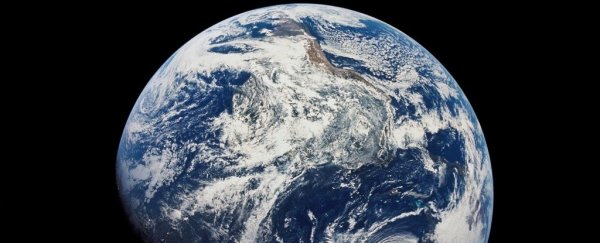One can only hope that never (again) will a substantially-sized asteroid come barrelling towards Earth. But if it should happen, we're now better prepared for it: MIT scientists have come up with a decision map for figuring out the best response in the event of an incoming asteroid crisis.
The decision map weighs up factors like an asteroid's mass and momentum, and then predicts the most effective way of avoiding a collision if it looks like the object will hit Earth's gravitational keyhole – that window of space where a hit would be guaranteed.
At the end of the decision map are three choices: steering the asteroid away with a projectile; sending a scout up to take more measurements; or sending two scouts up to take more measurements and maybe shift the path of the asteroid slightly (making the projectile option easier further down the line).
"People have mostly considered strategies of last-minute deflection, when the asteroid has already passed through a keyhole and is heading toward a collision with Earth," says aerospace engineer Sung Wook Paek.
"I'm interested in preventing keyhole passage well before Earth impact. It's like a preemptive strike, with less mess."
The idea behind the simulation code that Paek and colleagues have come up with is to reduce uncertainty. Tracking an asteroid and working out ways to deflect it involves a huge number of variables, some of which can't be known all that precisely.
Importantly, the decision process the researchers have come up with takes into account the amount of time before an asteroid potentially hits the keyhole, and also considers the range of uncertainty that is involved in any scenario.
"Does it matter if the probability of success of a mission is 99.9 percent or only 90 percent?" says aerospace engineer Olivier de Weck. "When it comes to deflecting a potential planet-killer, you bet it does.
"Therefore we have to be smarter when we design missions as a function of the level of uncertainty. No one has looked at the problem this way before."
While the probability of something significant hitting us remains low, it's not beyond the bounds of possibility, and even with modern-day scientific instruments, asteroids can sneak up on us. Advance planning is therefore crucial.
The simulation was tested on the asteroids Apophis and Bennu, which are two of the nearby asteroids we know most about – and among those with the highest chance of striking Earth one day. Apophis has a 1 in 150,000 chance of striking in 2068, while Bennu has a 1 in 2,700 chance of hitting Earth between 2175 and 2199.
That gives us plenty of time to prepare and continue to recalculate the odds. If Apophis is five years out from a potential keyhole pass, for example, two scouts followed by a "major impactor" should do the job of keeping it safely away. Once that time window shrinks to less than a year, it might already be too late to stop it.
The Bennu results were very similar, though we know a little bit more about what it's made up of – and that means sending up a rocket blast straight away might be the best course of action.
In short, the map should mean we're spending less time deciding what to do rather than actually doing it.
"Instead of changing the size of a projectile, we may be able to change the number of launches and send up multiple smaller spacecraft to collide with an asteroid, one by one," says Paek.
"Or we could launch projectiles from the moon or use defunct satellites as kinetic impactors. We've created a decision map which can help in prototyping a mission."
The research has been published in Acta Astronautica.
